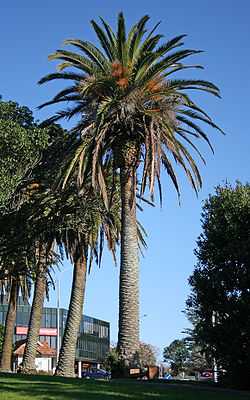Phoenix canariensis
| Canary Island date palm | |
|---|---|
 | |
| Phoenix canariensis | |
| Scientific classification | |
| Kingdom: | Plantae |
| (unranked): | Angiosperms |
| (unranked): | Monocots |
| (unranked): | Commelinids |
| Order: | Arecales |
| Family: | Arecaceae |
| Genus: | Phoenix |
| Species: | P. canariensis |
| Binomial name | |
| Phoenix canariensis Chabaud | |
Phoenix canariensis is a species of flowering plant in the palm family Arecaceae, native to the Canary Islands. It is a relative of Phoenix dactylifera, the true date palm. It is the natural symbol of the Canary Islands, together with the canary Serinus canaria.[1]
Description
Phoenix canariensis is a large solitary palm, 10–20 m (33–66 ft) tall, occasionally growing to 40 m (131 ft). The leaves are pinnate, 4–6 m (13–20 ft) long, with 80–100 leaflets on each side of the central rachis. The fruit is an oval, yellow to orange drupe 2 cm (0.79 in) long and 1 cm (0.39 in) in diameter and containing a single large seed; the fruit pulp is edible but too thin to be worth eating.
Names
The most used common name in English is Canary Island Date Palm. The common name in Spanish speaking countries and in the Canary Islands is palmera canaria. It has sometimes mistakenly been called a pineapple palm but, it is not related to pineapples at all, which are grown low to the ground and not on trees.
Cultivation
The Canary Island date palm is very widely planted as an ornamental plant in warm temperate regions of the world, particularly in areas with Mediterranean climates but also in some areas with a mild oceanic climate, such as Ireland and the Channel Islands.[2] It can be cultivated where temperatures never fall below −10 or −12 °C (14 or 10 °F) for extended periods, although it will require some protection if cold periods are longer than normal. It is a slowly growing tree, exclusively propagated by seed.
The palm is easily recognized through its crown of leaves and trunk characteristics. It is not uncommon to see Canary Island date palms pruned and trimmed to enhance the appearance.[3] When pruned, the bottom of the crown, also called the nut, appears to have a pineapple shape.
It has gained the Royal Horticultural Society's Award of Garden Merit.[4]
Other uses
In the Canary Islands, the sap of this date palm is used to make palm syrup. La Gomera is where most of the sap is produced in the Canary Islands.
Invasiveness
In some mediterranean and subtropical countries, P. canariensis has proven to be an invasive plant. In New Zealand, it has invaded a range of habitats. New Zealand's Landcare Research has classified the palm as a 'sleeper weed' - "a plant that spreads slowly and goes unnoticed until it becomes widespread". It is also considered naturalised in Spain, Italy, Australia, Bermuda and parts of the United States (California, Arizona, Southern Nevada, Florida and Alabama).[5][6] In Auckland, New Zealand, the palm has itself become a host for the naturalised Australian strangler fig, Ficus macrophylla.
References
- ↑ Ley 7/1991, de 30 de abril, de símbolos de la naturaleza para las Islas Canarias - in spanish
- ↑ "Palms in the Channel Islands – by Michael A.F. Carter". The European palm Society. Retrieved 12 December 2013.
- ↑ http://realpalmtrees.com/palm-blog/a-e/canary-island-date-palm-phoenix-canariensis/
- ↑ "RHS Plant Selector - Phoenix canariensis". Retrieved 25 May 2013.
- ↑ httpKew World Checklist of Selected Plant Families, Phoenix_canariensis
- ↑ Biota of North America Program, map, Phoenix_canariensis
External links
- Principes (Journal of the International Palm Society) Phoenix canariensis in the wild, Vol 42, No 2, April 1998. Accessed 18 May 2008.
| Wikimedia Commons has media related to Canary Island Date Palm. |